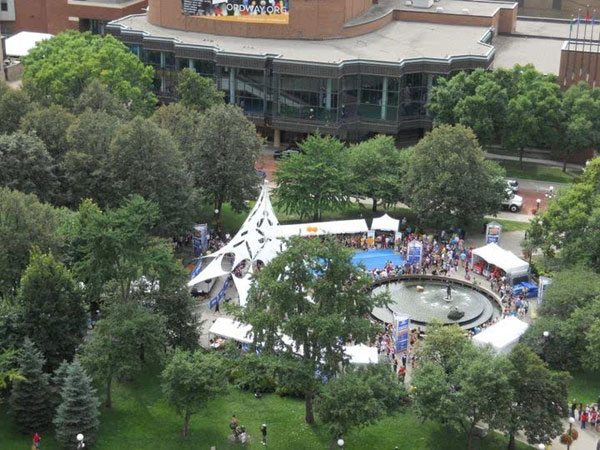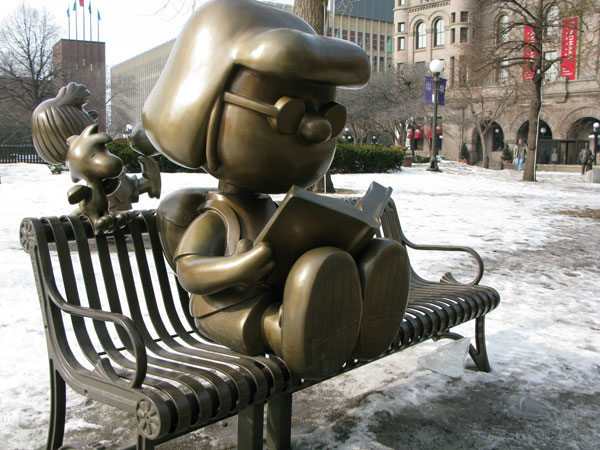Rice Park: St. Paul, Minnesota

Summary
Rice Park is a counterpoint to its busy surroundings. Its period lamps, statuary, benches, center fountain, and adjacent national landmark buildings lend a European feeling to the space. Trapezoidal in shape with two diagonal walkways, the park serves as much as a pathway and shortcut as it does a lunch stop, festival grounds, and outdoor sanctuary. Rice Park has undergone far-reaching changes since its establishment in 1849, when Minnesota was still a territory.
Designated Area
The park is bound by North Market Street to the east, North Washington Street to the west, West 5th Street to the north, and West 4th Street to the south.

Rice Park is bordered by historic buildings, museums, and music halls, offering an old-world European charm to downtown St. Paul. The central feature is a fountain designed by a Wisconsin artist in 1965. Photo courtesy St. Paul Parks and Recreation.
Planning Excellence
Initially used to dry laundry or graze animals, the park's first amenities — a fountain and bandstand — were added in the 1870s. Electric lights were installed in 1883 for a visit by President Chester A. Arthur and Generals Ulysses S. Grant and William Tecumseh Sherman, who traveled to St. Paul to recognize the opening of Northern Pacific's West Coast rail line.
Construction of the historic buildings, museums, and music halls that eventually bordered the park spanned nearly 100 years starting with the impressive Richardsonian Romanesque Landmark Center (formerly the Federal Building) on 5th Street West. Designed by Willoughby J. Edbrooke, it opened in 1902. The luxury St. Paul Hotel, built on Market Street, opened in 1910, and the Renaissance-styled Saint Paul Central Library and James J. Hill reference collection opened in 1917 across from the park on 4th Street West. The last major building to be erected opposite the park was the Ordway Center for the Performing Arts, which opened on Washington Street in 1985.
In addition to this construction and the subsequent renovations of the three early 20th century buildings facing the public space, Rice Park itself underwent two major renovations. The first, in 1965, was spearheaded by the Women's Institute of Saint Paul. It was followed by another in 2000 involving several businesses, organizations, societies, and individuals. The result is a remarkable 1.6-acre parcel that brings a little old-world European charm to downtown St. Paul.

By the 1960s the park and surrounding buildings fell into a period of neglect. Rice Park underwent two major renovations in 1965 and 2000, and the area surrounding the park has seen nearly $63 million in revitalization.
Defining Characteristics, Features
History, renovations
- Donated to city by territorial delegate and later U.S. Sen. Henry M. Rice and territorial pioneer John Irvine; referred to as "Irvine & Rice's addition"
- Mayor John Prince added shade trees in 1860; city parks superintendent Frederick Nussbaumer credited with preserving Rice Park's role as a significant public space during late 1800s despite pressures to change the park's purpose as a result of the Federal Courts Building (1902; now called Landmark Center)
- By 1960s park and surroundings endured a period of neglect and deterioration; park renovations begin with Hammel, Green, and Abrahamson design of 1965; activists during the 1970s and 1980s save Federal Courts Building from demolition; major renovation of St. Paul Hotel changes building's front entrance to face park
- The park's centerpiece, a statue and fountain by Wisconsin artist Alonzo Hauser, donated by the Women's Institute of Saint Paul in 1965; referred to as The Source
- 1980 park renovations include replacement of benches and paths; 2000 renovation included redesign of fountain area provide access in accordance with Americans with Disabilities Act
- Area immediately surrounding park seen nearly $63 million in development; mixed-use, transit-oriented development involving light rail underway nearby; accessible by several bus routes and within walking distance of many major institutions and venues
Surrounding architecture, sculptures
- Both the Landmark Center, designed by Willoughby J. Edbrooke, and the Downtown Central Library, designed by Electus Litchfield and Charles Soule, are included in the National Register of Historic Places (1969 and 1975, respectively)
- Bronze statues of Charles Schulz's Peanuts characters Marcie, Woodstock, Peppermint Patty (2002); statues of prominent and nationally famous St. Paul residents including F. Scott Fitzgerald
- On the side of the Ordway Center are massive murals, such as the one featuring self-portraits from students at the International Academy LEAP high school
- Newer museums and other attractions nearby along with current area developments provides cultural revitalization to the areas east, west, and south of the park
Local support, activities
- Park maintained by city and Rice Park Association, a citizen group
- Location for parades, marches, and festivals; one of the venues for St. Paul's annual Winter Carnival, oldest and largest winter festival in the country (began 1886)
- Annual Rice Park Christmas tree and lighting; involves tree as tall as iconic Rockefeller Center tree, lit with energy-efficient LED lights; city maintains free ice skating rink one block from park throughout winter
- Live music featured in warmer months including blues, jazz, original compositions

Bronze sculptures, including these of Peanuts cartoon characters, can be found scattered about the 1.6-acre parcel. Photo courtesy St. Paul Parks and Recreation.


